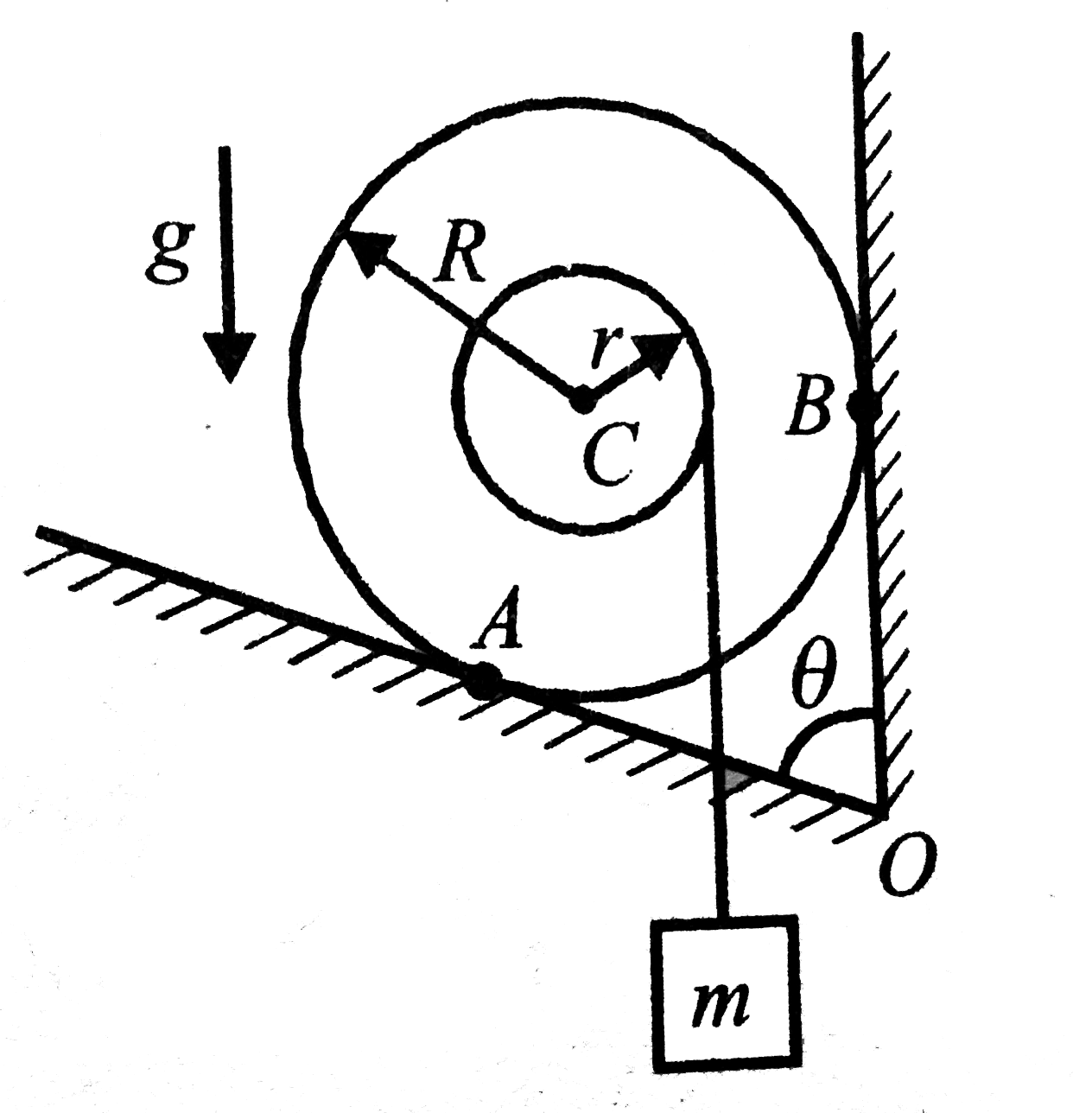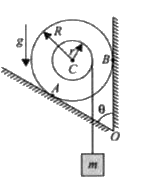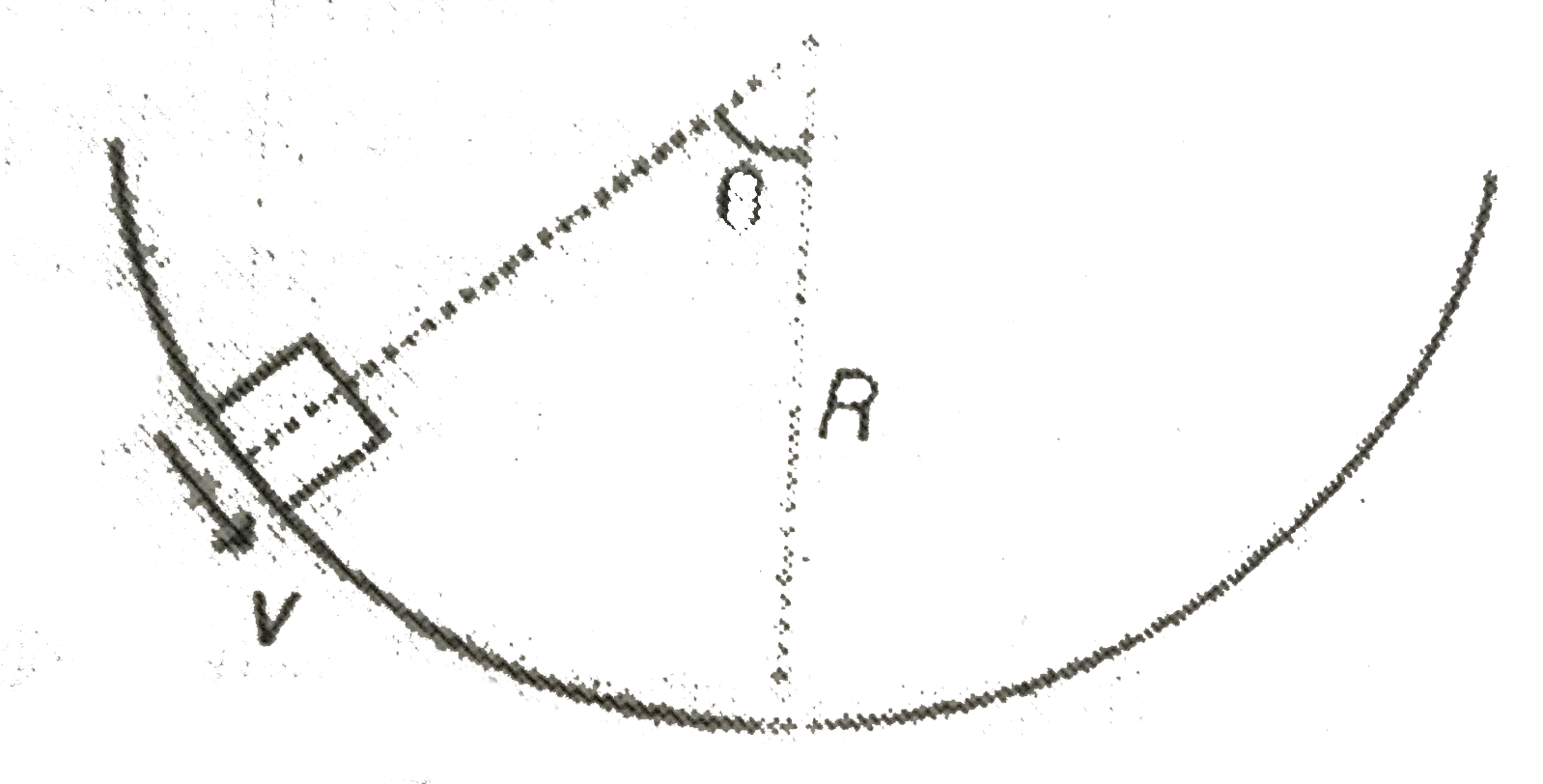A massless spool of inner radius r outer radius R is placed against a vertical wall and a titled split floor as shown. A light inextensible thread is tightly wound around the spool through which a mass m is hainging. There exists no friction at point A, while the coefficient of friction between the spool and point B is μ. The angle between the two surface is θ

The magnitude of force on the spool at B in order ot maintain equilibrium is mg√(rR)2+(1−rR)21tan2θ
The magnitude of force on the spool at B in order to maintain equilibrium is mg (1−rR)1tan2θ
The minimum value of μ for the system to ramain in equilibrium is cotθ(R/r)−1
The minimum value of μ for the system to ramain in equilibrium is tanθ(R/r)−1
The correct Answer is:A, D
Step by step video, text & image solution for A massless spool of inner radius r outer radius R is placed against a vertical wall and a titled split floor as shown. A light inextensible thread is tightly wound around the spool through which a mass m is hainging. There exists no friction at point A, while the coefficient of friction between the spool and point B is mu. The angle between the two surface is theta by Physics experts to help you in doubts & scoring excellent marks in Class 11 exams.
Updated on:21/07/2023Topper's Solved these Questions
- ROTATIONAL MOTIONBOOK - DC PANDEYCHAPTER - ROTATIONAL MOTIONEXERCISE - Comprehension Type Questions
41 Videos
- ROTATIONAL MOTIONBOOK - DC PANDEYCHAPTER - ROTATIONAL MOTIONEXERCISE - Matrix Matching Type Questions
17 Videos
- ROTATIONAL MOTIONBOOK - DC PANDEYCHAPTER - ROTATIONAL MOTIONEXERCISE - A Only One Option is Correct
86 Videos
- ROTATIONAL MECHANICSBOOK - DC PANDEYCHAPTER - ROTATIONAL MECHANICSEXERCISE - Subjective Questions
2 Videos
- SEMICONDUCTORS AND ELECTRONIC DEVICESBOOK - DC PANDEYCHAPTER - SEMICONDUCTORS AND ELECTRONIC DEVICESEXERCISE - More than One Option is Correct
3 Videos
Similar Questions
On the figure shown two blocks each of mass 2 kg are connected though a massless inextensible string, which posses over a frictionless pulley. The coefficient of friction between any two surface is μ=0.1. Find the acceleration of the blocks.

View SolutionA uniform ladder of length 3.25 m and weight 250 N is placed against a smooth vertical wall with its lower end 1.25 m from the wall. If coefficient of friction between the ladder and the floor is 0.3, then, find the frictional force acting on the ladder at the point of contact between ladder and floor.
View Solution
Knowledge Check
A massless spool of inner radius r outer radius R is placed against a vertical wall and a titled split floor as shown. A light inextensible thread is tightly wound around the spool through which a mass m is hainging. There exists no friction at point A, while the coefficient of friction between the spool and point B is μ. The angle between the two surface is ρ
 AThe magnitude of the force on the spool at B in order to maintain equilibrium is mg√(rR)2+(1−rR)21tan2θBThe magnitude of the force on the spool at B in order to maintain equilibrum is mg(1−rR)1tanθCThe minimum value of μ for the system to remain in equilibrium is cotθ(R/r)−1DThe minimum values of μ for the system to remain in equilibrium is tanθ(R/r)−1
AThe magnitude of the force on the spool at B in order to maintain equilibrium is mg√(rR)2+(1−rR)21tan2θBThe magnitude of the force on the spool at B in order to maintain equilibrum is mg(1−rR)1tanθCThe minimum value of μ for the system to remain in equilibrium is cotθ(R/r)−1DThe minimum values of μ for the system to remain in equilibrium is tanθ(R/r)−1A massless spool of inner radius r, outer radius R is placed against vertical wall and tilted split floor as shown. A light inextensible thread is tightly wound around the spool through which a mass m is hanging. There exists no friction at point A, while the coefficient of friction between spool and point B is μ . The angle between two surface is θ.
 AThe magnitude of force on the spool at B in order to maintain equilibrium is
AThe magnitude of force on the spool at B in order to maintain equilibrium is
mg√(rR)2+(1−rR)21tan2θBThe magnitude of force on the spool at B in order to maintain equilibrium is mg (1−rR)1tanθCThe minimum value of μ for the system to remain in equilibrium is cotθ(R−r)−1DThe minimum value of μ for the system to remain in equilibrium is tanθ(R−r)−1.A solid cylinder of mass m and radius r is rolling on a rough inclined plane of inclination θ. The coefficient of friction between the cylinder and incline is μ. Then.
Africtional force is always μmgcosθBfriction is a dissipative forceCby decreasing θ, frictional force decreasesDfrictiona opposes translation and supports rotation.
A mass of mass 60kg is pulling a mass M by an inextensible light rope passing through a smooth and massless pulley as shown in figure. The coefficient of friction between the mass and ground is μ=1/2 find the maximum value of M that can be pulled on the ground

View SolutionA ladder of length l and mass m is placed against a smooth vertical wall, but the ground is not smooth. Coefficient of friction between the ground and the ladder is μ. The angle θ at which the ladder will stay in equilibrium is
View SolutionA hollow sphere of mass m and radius R is rolling downdard on a rough inclined plane of inclination θ. If the coefficient of friction between the hollow sphere and incline is μ, then
View SolutionA block of mass m=1kg has a speed v=4m/s at θ=60∘ on a circular track of radius R = 2 m as shown in figure. Size of the block is negligible. Coefficient of friction between block and the track is μ=0.5. The force of friction between the two is

View SolutionA ring of radius R is first rotated with an angular velocity ω and then carefully placed on a rough horizontal surface. The coefficient of friction between the surface and the ring is μ. Time after which its angular speed is reduced to half is
View Solution
